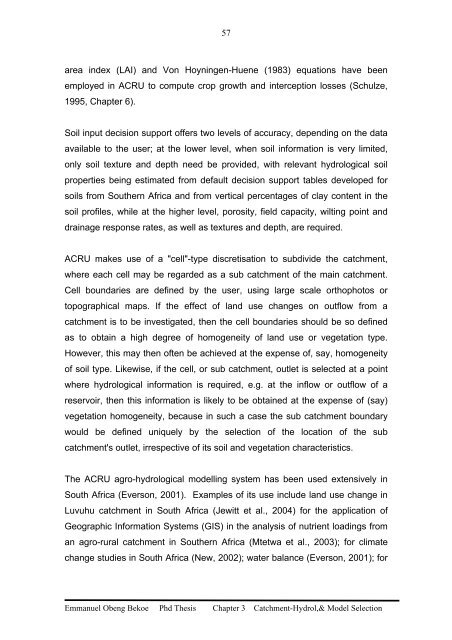PhD Thesis Emmanuel Obeng Bekoe - Cranfield University
PhD Thesis Emmanuel Obeng Bekoe - Cranfield University
PhD Thesis Emmanuel Obeng Bekoe - Cranfield University
You also want an ePaper? Increase the reach of your titles
YUMPU automatically turns print PDFs into web optimized ePapers that Google loves.
57<br />
area index (LAI) and Von Hoyningen-Huene (1983) equations have been<br />
employed in ACRU to compute crop growth and interception losses (Schulze,<br />
1995, Chapter 6).<br />
Soil input decision support offers two levels of accuracy, depending on the data<br />
available to the user; at the lower level, when soil information is very limited,<br />
only soil texture and depth need be provided, with relevant hydrological soil<br />
properties being estimated from default decision support tables developed for<br />
soils from Southern Africa and from vertical percentages of clay content in the<br />
soil profiles, while at the higher level, porosity, field capacity, wilting point and<br />
drainage response rates, as well as textures and depth, are required.<br />
ACRU makes use of a "cell"-type discretisation to subdivide the catchment,<br />
where each cell may be regarded as a sub catchment of the main catchment.<br />
Cell boundaries are defined by the user, using large scale orthophotos or<br />
topographical maps. If the effect of land use changes on outflow from a<br />
catchment is to be investigated, then the cell boundaries should be so defined<br />
as to obtain a high degree of homogeneity of land use or vegetation type.<br />
However, this may then often be achieved at the expense of, say, homogeneity<br />
of soil type. Likewise, if the cell, or sub catchment, outlet is selected at a point<br />
where hydrological information is required, e.g. at the inflow or outflow of a<br />
reservoir, then this information is likely to be obtained at the expense of (say)<br />
vegetation homogeneity, because in such a case the sub catchment boundary<br />
would be defined uniquely by the selection of the location of the sub<br />
catchment's outlet, irrespective of its soil and vegetation characteristics.<br />
The ACRU agro-hydrological modelling system has been used extensively in<br />
South Africa (Everson, 2001). Examples of its use include land use change in<br />
Luvuhu catchment in South Africa (Jewitt et al., 2004) for the application of<br />
Geographic Information Systems (GIS) in the analysis of nutrient loadings from<br />
an agro-rural catchment in Southern Africa (Mtetwa et al., 2003); for climate<br />
change studies in South Africa (New, 2002); water balance (Everson, 2001); for<br />
<strong>Emmanuel</strong> <strong>Obeng</strong> <strong>Bekoe</strong> Phd <strong>Thesis</strong> Chapter 3 Catchment-Hydrol,& Model Selection

















